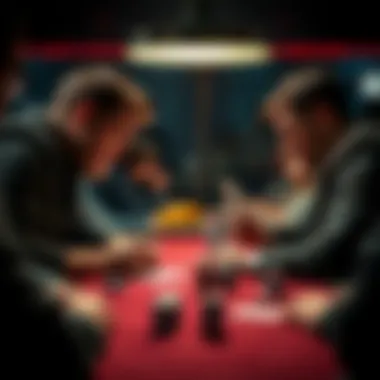Exploring Poker's Impact on Film and Popular Culture


Intro
The interplay between poker and cinema has always been a fascinating topic for both film aficionados and poker enthusiasts. Through the years, we have seen trends evolve that reflect societal attitudes towards gambling and risk. The flickering lights and the suspenseful moments depicted in films serve not merely as entertainment but as a lens into the psyche of players and the strategies they embrace to outwit their opponents.
In films, poker often symbolizes much more than just a game of chance; it is a battleground of wits, showcasing emotions ranging from despair to triumph. A perfect poker scene can encapsulate myriad themes such as deception, ambition, and chance—elements that resonate deeply in our day-to-day lives.
In this exploration, we will delve deeper into the art of storytelling within poker films, dissecting how character development intertwines with gameplay. By analyzing landmark movies, from cult favorites to mainstream hits, the nuances of betting strategies will become clearer. We'll scrutinize common blunders that players fall into during tense poker moments caught on camera and what this tells us about human nature. Ultimately, this piece aims to enhance your appreciation not only for poker as a game but also for its profound cultural significance as depicted in cinema.
With that in mind, let’s dive right in.
Prolusion to Poker in Film
The relationship between poker and film might seem a bit like pairing oil with water initially, yet, upon a closer inspection, you’ll find an intricate dance unfolding. Poker, often regarded as a battleground of wit, strategy, and psychology, translates remarkably well into the cinematic narrative. Not only does it serve as a gripping backdrop for various plots, but it also provides filmmakers a canvas to explore deeper themes of risk and reward, as well as human behavior under pressure.
Understanding the role of poker in films offers valuable insights for a diverse audience, ranging from casual viewers to professionals in gambling and gaming industries. Many films have used poker not just as a game, but as a lens to showcase the dynamism of human interaction, the stakes of life and death decisions, and even the moral complexities of winning at all costs.
As poker becomes an essential trope within character arcs, the question of what it means to play emerges. This leads to broader considerations: what are the motivations and backgrounds of the players? How do their experiences shape the game’s outcome? Each game at the table whispers stories of ambition, deceit, trust, and betrayal. Embracing the historical context helps one understand how filmmakers have continuously adapted poker's portrayal throughout the ages, sometimes even mirroring societal changes in perceptions of gambling itself.
From iconic films showcasing high-stakes games to independent short films that depict simple matches amongst friends, poker contributes to cinema's storytelling arsenal. It’s not merely about the cards dealt but encompasses broader emotional stakes transforming each hand into a metaphor for life choices.
Historical Context
The history of poker in film can be traced back more than a century, with its first notable appearance in silent films, where the game was minimal yet impactful. The game captured the essence of America’s burgeoning gambling culture during the late 19th and early 20th centuries. Films like "The Rounders" from 1916 illustrated poker as a way for everyday individuals to escape societal norms, a trend that would grow more pronounced over the decades.
As they say, timing is everything. The transition from silent films to “talkies” facilitated a unique way of portraying poker—capturing not just the game, but the dialogues and tensions around it. With the rise of Hollywood's golden age, audience cravings for thrilling narratives found poker's dramatic potential irresistible, leading to blockbuster films that brought the game into the limelight.
Fast forward to the late 20th century, and the poker boom is fully integrated into cinematic culture. The release of "Rounders" in 1998 was pivotal—molding how the game was viewed and played. Through films, audiences witnessed not just the cards but the personal stakes of the players involved. Poker's evolution in cinema reflects shifting societal trends, indicating a growing acceptance and intrigue around gambling.
Cinematic Appeal of Poker
The cinematic charm of poker lies not just in the game itself, but in the way it encapsulates conflict and resolution. The poker table serves as a microcosm of life; each bet placed is a gamble not only on the cards but on relationships, ambitions, and ultimately one’s destiny. The focus on dramatic encounters, coupled with unexpected plot twists, keeps viewers glued to their screens.
Furthermore, filmmakers have a knack for using poker as a metaphor for larger social issues. The themes of trust, betrayal, and courage shine brightly as players vie for supremacy in high-stakes games. How does a character’s choice to bluff reflect their moral compass? How do alliances form—and shatter—over the whims of fate?
Here's where the beauty of visual storytelling comes into play. Clever lighting, close-up shots of players’ facial expressions, and the tension in their body language create an atmosphere thick with suspense. Sound effects, from shuffling cards to the clatter of chips, add layers to the experience, making one feel like part of the table.
Thus, it becomes clear: poker in film is not just a game to be played out; it’s a rich narrative device that contributes significantly to character development and thematic depth. Films invite viewers into a world laden with risks and predicaments, making it a compelling subject that continues to inspire filmmakers and captivate audiences alike.
Iconic Poker Movies
The portrayal of poker in cinema has left a notable imprint on popular culture, illustrating not just the game itself but also the personalities and strategies entwined with it. Films featuring poker often go beyond mere entertainment; they delve into themes of risk, psychology, and rivalry. Each iconic poker movie holds significance that reflects not just the nuances of the game, but also transcends into broader cultural commentaries. Notably, such films provide a common ground, sparking interest among gamblers, casual watchers, and cinephiles alike.
Rounders
Plot Summary
Rounders chronicles the journey of Mike McDermott, a talented poker player who aims to reclaim his lost fortune. Straddled with the burden of student loans and the need to uphold his commitments, Mike walks the razor-thin line between his aspirations as a law student and the seductive allure of high-stakes poker. The plot beautifully illustrates how personal stakes are intertwined with the game, reinforcing the message that poker is not merely about cards but about life choices and consequences.
The film's emphasis on character-driven storytelling sets it apart from other titles. It does more than showcase poker; it reveals the emotional undercurrents that drive individuals to the table. The unique aspect of Rounders lies in its portrayal of poker as a vehicle for existential exploration rather than just a pastime. This focus on personal stakes makes it a beneficial choice for understanding how cinema can elevate the game into something profoundly philosophical.
Cultural Impact
The cultural impact of Rounders is monumental, shaping public perception and the image of poker as a high-stakes sport rather than mere gambling. It ignited a poker boom in the late 1990s, introducing millions to the game. The iconic phrases, like "All in" and "You gotta see this," became part of everyday language. Mike’s character—even today—embodies the aspirational figure for many who wish to combine intellect with risk-taking.
This film also highlights the communal and adversarial aspects of poker, showcasing friendships forged and tests of loyalty that extend beyond the game. A unique feature here is its ability to transcend generational gaps, continuing to resonate with new audiences. Its charm remains timeless, allowing discussions about morality, strategy, and the ethics involved in both life and poker.
Critical Reception
Critically, Rounders garnered mixed initial reactions, with critics accentuating the film's depth despite its niche appeal. What sets the receptions apart is how over the years, it transformed into a cult classic—one that is loved by poker enthusiasts. With its clever dialogue and grounded performances, the film echoed authenticity, allowing viewers to feel the weight of each decision at the poker table.
The unique characteristic of its critical reception is that it cements the movie's place in gambling lore, showcasing how audiences interpret emotional narratives woven with tension and excitement. Although it features some traditional tropes of crime dramas, its affective storytelling provides richer ground for analysis within the realm of gambling films.
Casino Royale
Analysis of Poker Scenes
In Casino Royale, poker scenes are not mere decorations; they act as a fulcrum around which the plot pivots. The film adeptly encapsulates the thrill of action and strategy, revealing character motivations while maintaining suspense. The unique setting of a high-stakes tournament positioned in an exotic locale adds allure, making it more than just a game; it becomes a battleground for wits.


The visual storytelling of these sequences, with close-ups capturing the intensity of the players, contributes to the overall narrative arc. The scenes reveal not only the intellectual rivalry between characters but also play a crucial role in forming alliances, betrayals, and survival. This layer of complexity makes it a favorable analysis point within this article.
Character Dynamics
Casino Royale does not merely feature poker for entertainment; it utilizes the game as a lens through which viewers can witness evolving character dynamics, particularly between Bond and his adversaries. The evolving relationships are illustrated through tension-filled hands, revealing vulnerabilities and strategic shifts. In this light, poker becomes a metaphor for the larger game of espionage, layering significance beyond the table.
What stands out are the psychological battles that unfold, demonstrating how each character's approach to poker reflects their personalities—whether bold, calculated, or reckless. This nuanced representation poses significant insights for audiences, as they witness how one's poker face reflects deeper motivations.
Significance in the Bond Franchise
Within the context of the Bond franchise, poker in Casino Royale signifies a pivotal shift. Traditionally, the series has relied on gadgets and action, yet here, a more cerebral approach takes center stage. The portrayal of poker matches mirrors the essence of Bond's world, where deception reigns supreme.
This unique feature not only engages audiences but also restores an element of unpredictability—unlike the traditionally action-driven plots, this shift invites viewers back to the intellectual intrigue synonymous with Ian Fleming's works. This redefinition of the high-stakes game in a spy context serves to broaden how viewers engage with the film, making it a critical point of discussion in any analysis of poker's cinematic portrayal.
Maverick
Comedy vs. Strategy
In Maverick, the interplay between comedy and strategy delivers a light-hearted take on poker, reveling in both the game’s intricacies and its social aspects. By using humor, the film masks the underlying tension often associated with high-stakes poker, engaging viewers from a more relatable perspective. This presents an interesting duality as it contrasts the serious environments typically portrayed in gambling films.
This unique blend effectively showcases how poker serves both as a mental exercise and a social gathering, where playful deception and charm come into play. Therefore, analyzing this comedic angle is essential, as it invites different interpretations and engages a wider audience, possibly drawing in those who might find traditional poker narratives daunting.
Character Development
Character development in Maverick intertwines deeply with poker gameplay. The protagonist, Bret Maverick, embodies a charismatic rogue who utilizes charm and bluffing rather than strict strategy. His journey illustrates the evolution of confidence and cunning in the face of obstacles. The comedy woven with the character arc allows audiences to connect emotionally, witnessing firsthand how character flaws can translate into unique strengths at the poker table.
This type of character progression adds depth to the film, allowing viewers to reflect on their own vulnerabilities in pursuit of success. It reinforces the idea that whether in poker or life, one’s quirks can become hallmarks of their distinct approach.
Impact on Perception of Poker
The representation of poker in Maverick significantly shapes audience perceptions, displaying it as an entertainment realm layered with personality and craftsmanship rather than mere gambling. By showcasing the game’s dynamics in a more comedic light, the film invites discussions on the different ways individuals approach risk and rewards.
This approach can alter public perception of poker from a serious gambling activity to a game that celebrates wit and cleverness, appealing to a more diverse audience. By effectively combining humor with strategical gameplay, Maverick becomes a seminal reference point in discussions around how the game is portrayed within cinematic contexts.
Psychology and Strategy in Poker Films
Poker extends beyond mere card games; it's a vivid portrayal of human psychology at its best. When represented in films, the game reflects not just the strategy involved but also the intricate mental battles that players engage in. This section aims to peel back the layers of human behavior, motivation, and decision-making processes that filmmakers often showcase through poker scenes. The combination of psychology and strategy brings a profound depth to the narrative, making it all the more captivating for both gambling enthusiasts and casual viewers alike.
Reading Opponents
Psychological warfare is an integral element in poker, and one key tactic involves reading opponents. The ability to anticipate an adversary's moves and intentions can tip the scales in one's favor. In the realm of cinema, the depiction of this skill can elevate the tension in a scene, drawing viewers into the intricacies of the game.
Nonverbal Communication
An actor's ability to convey a message without uttering a single word can be immensely powerful. Nonverbal communication in poker films often takes the form of facial expressions, body language, and eye movements. For instance, a subtle twitch or a fleeting glance can reveal more than dialogue can.
- Key characteristic: The reliance on body language to signify emotions or thoughts creates a richer layer to various scenes.
- Reason for choice: It's a beneficial choice because it adds realism and intensity to interactions between players, making the stakes feel palpably high.
- Unique features: A director might focus on the slight shift of a player's posture or the tension in their fingers hovering over the cards.
- Advantages: This technique immerses viewers by reinforcing the importance of detail in assessing competition.
However, an over-reliance on nonverbal cues can also lead to misinterpretations, which shifts the focus away from actual gameplay.
Behavioral Cues
Along with nonverbal communication, behavioral cues play an essential role in how players assess each other. These cues often transcend mere physical actions and involve more subtle psychological indicators. A fidgeting player may exhibit signs of anxiety, potentially inducing a decision-making blunder while a calm demeanor might indicate confidence.
- Key characteristic: Behavioral cues encapsulate a range of actions, from tapping fingers to repetitive movements.
- Reason for choice: Their integration gives filmmakers the chance to heighten dramatic tension, keeping viewers at the edge of their seats.
- Unique features: Particular focus on how players manage their nervous habits can lead to revealing insights about their psychological state.
- Advantages: This adds another layer for the viewer to analyze, enhancing their engagement with the film.
The drawback, however, lies in the possibility that some viewers may misconstrue these signs, which can lead them astray in understanding the underlying gameplay and dynamics among players.
Bluffing and Deception
The foundation of poker revolves around bluffing and deception—skills that can define a game just as much as the cards on the table. Movies often dramatize this psychological dueling, allowing audiences to witness intricate strategies unfold in real-time.
Cinematic Techniques
Cinematography plays a pivotal role in highlighting the nuances of bluffing. Close-ups and dramatic lighting can create an emotionally charged atmosphere, making moments of deception all the more impactful. Filmmakers often employ various techniques to capture the essence of a bluff.
- Key characteristic: Close-ups on players' faces can magnify tensions and highlight the stakes of the moment.
- Reason for choice: Utilizing these cinematic techniques facilitates an authentic representation of the internal struggles players face while engaging in deception.
- Unique features: Innovative editing might weave between players' reactions and the gameplay, allowing viewers to experience the suspense.
- Advantages: These methods help anchor emotional resonance for the audience while advancing the plot.
On the flip side, an overuse of such cinematic devices may detract from the authenticity of poker gameplay and skew viewers' understanding of how bluffing operates in real-life situations.
Realism vs. Artistic License
In the realm of poker films, finding the balance between realism and artistic license can be tricky. Movies often take liberties with the intricacies of the game for dramatic effect.
- Key characteristic: Artistic choices may exaggerate scenarios or sentimentalize the experience for emotional impact.
- Reason for choice: Granting filmmakers the freedom to twist reality allows for enhanced story arcs, making the game not just a backdrop but a centerpiece in the narrative.
- Unique features: Iconic poker scenes often play into tropes, like the tension before revealing cards, which might not happen as dramatically in real life.
- Advantages: When done well, this can amplify the entertainment value, drawing the audience deeper into both the plot and the emotional stakes involved in the game.
However, such deviations risk misrepresenting the technicalities of poker. A lack of realism might mislead players or influence them toward unrealistic tactics in their own game.
In essence, the intersection of psychology and strategy in poker films opens a wealth of narrative possibilities. It creates a rich tapestry that weaves together human behavior, cognitive strategies, and the high-octane thrill of the game, ultimately crafting a compelling cinematic experience.
Evolving Representation of Poker
The depiction of poker in cinema has undergone significant changes over the decades, mirroring broader social and cultural shifts. The evolving representation of poker not only reflects the game’s changing popularity but also highlights its cultural significance and its ability to adapt in conjunction with societal developments. Examining this evolution provides insights into how filmmakers have approached the game's themes, characters, and contexts throughout various eras. This section focuses on the important aspects of poker's depiction, its evolution from classic to contemporary representations, and how diversity in characters has played a vital role in shaping viewer perceptions.
From Classic to Contemporary
Changes in Themes
The themes surrounding poker in movies have transitioned from primarily focusing on the high stakes and almost romantic portrayal of the game to a deeper exploration of morality, personal conflict, and psychological strategy. Earlier films often romanticized poker as a game of chance, where luck played a significant role, reflecting a more simplistic understanding of gambling.
The shift in themes, however, introduces a more nuanced narrative structure in contemporary films. Modern storytelling frequently emphasizes the psychological elements of the game, focusing less on luck and more on strategy and deception. This not only enhances the suspense and complexity of poker but also engages the audience at a deeper emotional level.
This evolution is beneficial as it allows filmmakers to explore moral dilemmas that can arise from gambling. For instance, characters may wrestle with their integrity, revealing their flaws as they navigate the dangerous waters of poker. The unique feature here is that poker becomes a canvas for exploring human behavior, morality, and the effects of gambling addiction.
Technology in Poker
Technological advancements have also transformed the representation of poker in cinema. Films increasingly incorporate elements of technology ranging from online poker to sophisticated analytics used by players. This shift is particularly evident with the rise of digital poker games, which have paved the way for greater access and participation in the game.
The integration of technology into poker film narratives highlights a society that is rapidly digitizing. It reflects the access players now have to vast amounts of data and tools that are reshaping strategies within the game. This modern perspective resonates with audiences familiar with digital platforms, making poker more relatable and engaging for new generations.
However, the growth of technology can blur the lines between traditional gaming and its digital counterpart. While it modernizes the representation, it also poses the downside of potentially glorifying the detachment from the real-world consequences of gambling.
Diversity of Characters
Gender Representation
From its early days, poker films predominantly featured male-centric narratives, often reinforcing stereotypes associated with masculinity. However, as social awareness around gender representation grows, the industry has shifted to embrace female characters who bring complexity, depth, and authenticity to poker narratives.
The addition of strong female poker players not only provides much-needed representation but also helps to counteract outdated views that have long dominated the genre. By centering stories around women who possess both skill and ambition, films highlight that the psychological battles at the table transcend gender.
This diversity in gender representation provides audiences with a broader understanding of the game and challenges preconceived notions, making poker a more inclusive narrative in cinema.
Cultural Perspectives
Moreover, the cultural perspectives within poker films have evolved significantly, showcasing a more globally inclusive view. Earlier movies often depicted a homogenous representation of American culture; however, contemporary films draw from a wealth of multicultural influences.
This trend enhances narrative depth by introducing diverse backgrounds, values, and traditions that influence how different characters relate to poker. Each cultural lens offers unique insights into gambling behaviors and beliefs, which enriches the cinematic experience.
The advantage of showcasing varied cultural perspectives is that it allows audiences to connect with the essence of the game in ways they may not have considered, enriching their understanding and appreciation of poker's nuances.
In summary, the evolving representation of poker in cinema showcases a remarkable journey from glorified portrayals of chance to nuanced explorations of strategy, diversity, and cultural significance. These transformations not only enhance viewer engagement but also reflect broader societal changes making poker a true mirror of human interaction and culture.
Further resources on poker representation can be explored in Wikipedia, Britannica, and various gaming forums like Reddit for community discussions and insights.
Impact of Poker Movies on Popular Culture
Poker, as showcased in cinema, is more than just a game. It serves as a metaphor for life, risk, and human interaction. The impact of poker movies on popular culture is profound, blending entertainment with real-world implications. This influence extends into gambling trends, shifts in public perception, and the integration of poker-related terminology into everyday conversation.
Influence on Gambling Trends
Rise of Online Poker
The rise of online poker has changed the landscape drastically. With platforms like PokerStars and Full Tilt Poker, players can engage from the comfort of their homes. This convenience is a significant factor; it opens up poker to people who might not have access to traditional card rooms. The digital realm allows for a broader audience, with players of varying skill levels coming together to test their mettle against one another.
A notable feature of online poker is its accessibility; not only can one play at any time, but the variety of stakes available also caters to all types of players. This flexibility draws many in, pushing casual players to explore strategies they might not consider in a live setting. However, it also has downsides. For instance, the sheer volume of players can lead to a disconnection from the social aspects of the game, making it less personal and often more about the numbers than the people behind the cards.
Public Perception Shifts
The portrayal of poker in films often shapes how society views the game. When movies like "Rounders" focus on the skill and strategy involved, it elevates poker's status from merely a gambling game to a battle of wits. As a result, this narrative encourages a more nuanced understanding among the public, viewing it as a sophisticated pastime rather than just a vice.


Interestingly, this shift in perspective connects directly to the normalization of gambling in broader media. As poker becomes a regular feature in popular films and television shows, it leads to more open discussions about finances, risk, and decision-making in life. On the downside, there is a risk of glorifying gambling, which can lead to unhealthy habits for some viewers. Nonetheless, in the realm of cultural dialogue, how we talk about poker has certainly evolved, making awareness of its psychological and strategic elements more prevalent.
Cinematic References in Gaming
Video Games Inspired by Films
The merging of poker and video games has yielded some fascinating and innovative results. Titles like "Red Dead Redemption" and "Grand Theft Auto V" feature poker as a mini-game, allowing players to experience the thrill without stepping into a casino. This aspect not only enhances gameplay but also attracts a demographic that may be curious about poker culture without prior experience. Such games serve as an introduction, igniting interest in poker beyond their virtual walls.
A unique aspect of this phenomenon is its duality; while it provides entertainment, it also acts as a gateway into the more strategic side of poker. Gamers can appreciate the nuances, learning tactics and bluffing techniques that translate into real-world scenarios. However, while these games might foster interest, they can sometimes lack the authentic stakes found in traditional poker settings, reducing the seriousness of strategy to a mere game mechanic.
Poker Terms in Pop Culture
Poker has infiltrated the lexicon of popular culture, and its terminology reflects that influence. Phrases like "going all-in" or "the river" have transcended the poker table, becoming part of everyday dialogues. This adoption speaks volumes about the game's reach and relevance, intertwining it with themes of commitment and uncertainty that resonate widely among audiences.
Moreover, as poker terms find their way into various aspects of life and media, they have helped demystify the game, making it accessible to novices. However, there's a flip side: if these terms are used casually without understanding their significance, it risks trivializing the intricate strategies and skills involved in poker. Nevertheless, the integration of poker jargon into common speech showcases poker's lasting imprint on contemporary culture.
"Cinema's portrayal of poker is not simply entertainment; it’s a window into the human psyche and societal perceptions of risk and reward."
In summary, the impact of poker movies on popular culture runs deep, influencing everything from gambling trends to colloquial language. As we explore how these films shape our understanding and engagement with the game, it becomes clear that poker is more than just cards and chips. It's a phenomenon that reflects and shapes societal dynamics.
Critical Analysis of Poker Representation
A critical analysis of how poker is depicted in films offers fascinating insights into a game that is as much about psychology and strategy as it is about risk and chance. This section highlights the necessity of evaluating poker representation in cinema as it affects both viewer perception and understanding of the game itself. By dissecting the various layers that contribute to these representations, we can better appreciate the nuances and implications that poker films have on popular culture.
Realism versus Fiction
Accurate Depictions
In the realm of poker films, accurate depictions serve as the faithful mirror reflecting the game’s essence. Films that strive for authenticity often delve into the intricacies of poker strategy, showcasing the real-life skills needed to navigate a high-stakes game. This meticulous representation not only captivates poker enthusiasts but also garners respect from the general audience. A key characteristic of accurate portrayals is how they seamlessly integrate game mechanics like pot odds, bluffing techniques, and psychological warfare into the narrative.
The socio-cultural weight of accurate depictions lies in their ability to educate viewers about the complexities of poker. This educational aspect enriches the film’s narrative, making it more than mere entertainment. However, the downside is that overly technical representations can alienate casual viewers who might find themselves left in the dark. A unique feature of accurate depictions is the layering of storylines with real poker scenarios, creating an engaging experience that can sometimes feel overwhelming for those new to the game.
Dramatic License
On the flip side, dramatic license allows filmmakers to stretch reality, creating narratives that may not accurately represent poker but instead prioritize emotional engagement. This technique often incorporates elements of suspense or elevated stakes that wouldn’t necessarily occur in a real game. The key characteristic of this approach is its potential to heighten drama, making for an enthralling cinematic experience. It shifts focus from minute gameplay details to larger thematic constructs like betrayal, triumph, or personal redemption.
The crowning advantage of dramatic license is that it opens the door for diverse storytelling opportunities. For instance, it can lead to unforgettable moments in films like Casino Royale, which showcases poker not just as a game but as a life-altering gamble. However, when too much dramatic license is employed, it risks creating a misleading image of poker that can skew public perception. The unique feature associated with this approach is the ability to weave poker into broader narratives, enriching character arcs at the expense of accuracy.
Audience Interpretation
Viewer Engagement with Poker Concepts
Viewer engagement is crucial in how audiences interpret poker concepts portrayed in films. People often seek drama and excitement, and when presented properly, a poker scene can enthrall audiences and invite them to think critically about the strategies involved. The key characteristic here is that engaging poker scenes prompt viewers, especially those unfamiliar with the game, to reassess their understanding of decision-making and risk in various life scenarios. Engagement can spark further interest in learning the game, shifting perceptions about poker from a gamble to a skill-focused endeavor.
Nevertheless, this engagement can yield mixed results. Those who do not possess a foundational understanding might find their excitement dampened, unable to grasp the weight of certain decisions depicted on-screen. The unique aspect of viewer engagement is how it transforms spectators into participants, encouraging them to apply poker logic in their day-to-day lives, thus bridging the gap between fiction and reality.
Educational Value of Films
Films based on poker can also serve as valuable educational tools for audiences. They illuminate various strategic facets of the game, such as probability assessments and psychological manipulation. The key characteristic of this educational value is that they provide viewers a window into the tactical mindset of successful players. This can lead to a better grasp of the game’s nuances, elevating a person’s experience of both viewing and potentially playing poker themselves.
However, the reliability of these films rests on the accuracy of the depictions presented. Misleading portrayals can lead to misconceptions, where audiences might emerge with an erroneous understanding of the strategies involved. A compelling unique feature of the educational value is that it taps into the instinctive human inclination to learn through storytelling, adding an immersive layer to lessons in strategy and psychology.
"Poker in cinema is not merely about cards; it teaches us about life, choices, and the art of deception."
End
The relationship between poker and cinema is not merely a backdrop for entertainment; it is a dynamic interplay that reflects broader cultural themes and psychological insights. This article sheds light on this bond by tracing the roots of poker’s cinematic portrayal to its evolution in modern storytelling. The significance of this topic lies in several key elements:
- Cultural Reflection: Poker, as depicted in films, often mirrors societal attitudes toward risk, chance, and decision-making. By analyzing how this card game is portrayed, we can gain a deeper understanding of the human experience and its complexities.
- Insightful Strategy and Psychology: The strategic elements involved in poker are often magnified in films, showcasing not just the rules of the game, but the psychological nuances and strategies players employ. This reveals much about character motivations and the underlying tension that drives narratives forward. Through the close examination of characters from films like Rounders or Casino Royale, we have seen how poker can serve as a metaphor for life, representing both the gambles we take and the hidden depths of human behavior.
- Impact on Popular Culture: The influence of poker films extends into the public subconscious. Terms and phrases from poker have woven their way into everyday language, shaping perceptions and trends in gambling practices. The rise of online poker, largely fostered by the excitement around cinematic portrayals, speaks volumes about the topic’s relevance to modern culture.
In wrapping up, we see that poker in cinema does more than entertain; it invokes curiosity, educational value, and a nuanced understanding of the game and its players.
Summary of Findings
This exploration covered various dimensions regarding poker in cinema, particularly how it has evolved and what it represents for audiences today. Key findings include:
- Iconic Films: Movies like Maverick, Rounders, and Casino Royale have established poker as a key narrative device, illustrating both the game and the characters who play it.
- Psychological Deep Dive: The portrayal of reading opponents and bluffing reveals a deeper comprehension of not just poker, but human interaction itself, adding layers to each character's story.
- Cultural Shifts: Over the years, the representation of poker has shifted to embrace diversity, showcasing stories that resonate with broader audiences.
Future of Poker in Cinema
Looking ahead, the future of poker in cinema seems poised for further evolution, nudged by changing technologies, societal values, and storytelling techniques. Here are a few considerations:
- Technology Integration: As online and virtual reality poker becomes more mainstream, expect filmmakers to incorporate these elements into their narratives, possibly shifting how poker is represented on-screen.
- Diverse Narratives: There may be a growing trend towards more inclusive storytelling that highlights voices and experiences not previously represented in the poker narrative, leading to richer, more varied cinematic experiences.
- Educational Opportunities: Films might increasingly serve not just to entertain but to educate, incorporating intricate strategies and the psychology of the game to demystify poker for broader audiences.
As we continue to witness the influence of poker in cinema, it speaks to a fundamental aspect of human nature: the allure of risk versus reward. As filmmakers explore new avenues and take fresh approaches, the relationship between this classic game and modern storytelling may very well become even more intricate than it is today.















